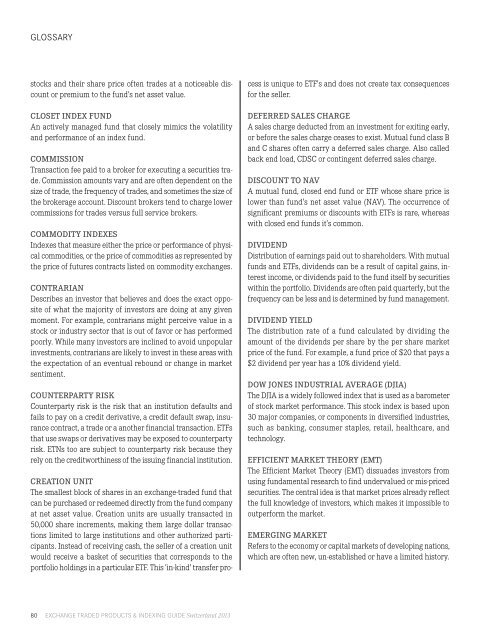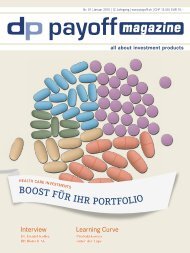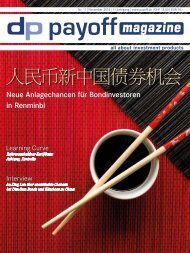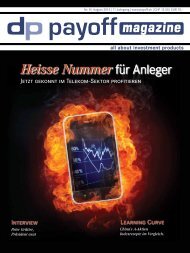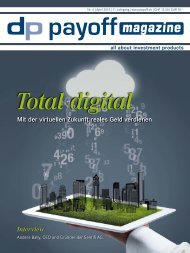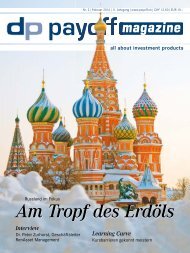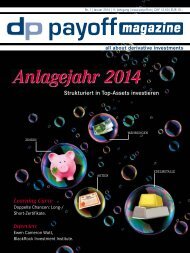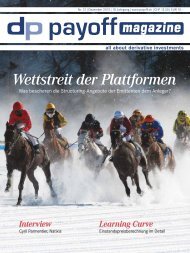Create successful ePaper yourself
Turn your PDF publications into a flip-book with our unique Google optimized e-Paper software.
glossarY<br />
stocks and their share price often trades at a noticeable discount<br />
or premium to the fund’s net asset value.<br />
CLOSET INDEX FUND<br />
An actively managed fund that closely mimics the volatility<br />
and performance of an index fund.<br />
COMMISSION<br />
Transaction fee paid to a broker for executing a securities trade.<br />
Commission amounts vary and are often dependent on the<br />
size of trade, the frequency of trades, and sometimes the size of<br />
the brokerage account. Discount brokers tend to charge lower<br />
commissions for trades versus full service brokers.<br />
COMMODITY INDEXES<br />
Indexes that measure either the price or performance of physical<br />
commodities, or the price of commodities as represented by<br />
the price of futures contracts listed on commodity exchanges.<br />
CONTRARIAN<br />
Describes an investor that believes and does the exact opposite<br />
of what the majority of investors are doing at any given<br />
moment. For example, contrarians might perceive value in a<br />
stock or industry sector that is out of favor or has performed<br />
poorly. While many investors are inclined to avoid unpopular<br />
investments, contrarians are likely to invest in these areas with<br />
the expectation of an eventual rebound or change in market<br />
sentiment.<br />
COUNTERPARTY RISK<br />
Counterparty risk is the risk that an institution defaults and<br />
fails to pay on a credit derivative, a credit default swap, insurance<br />
contract, a trade or a another financial transaction. ETFs<br />
that use swaps or derivatives may be exposed to counterparty<br />
risk. ETNs too are subject to counterparty risk because they<br />
rely on the creditworthiness of the issuing financial institution.<br />
CREATION UNIT<br />
The smallest block of shares in an exchange-traded fund that<br />
can be purchased or redeemed directly from the fund company<br />
at net asset value. Creation units are usually transacted in<br />
50,000 share increments, making them large dollar transactions<br />
limited to large institutions and other authorized participants.<br />
Instead of receiving cash, the seller of a creation unit<br />
would receive a basket of securities that corresponds to the<br />
portfolio holdings in a particular ETF. This 'in-kind' transfer pro-<br />
80 ExchangE TradEd ProducTs & IndExIng guIdE <strong>Switzerland</strong> <strong>2013</strong><br />
cess is unique to ETF's and does not create tax consequences<br />
for the seller.<br />
DEFERRED SALES CHARGE<br />
A sales charge deducted from an investment for exiting early,<br />
or before the sales charge ceases to exist. Mutual fund class B<br />
and C shares often carry a deferred sales charge. Also called<br />
back end load, CDSC or contingent deferred sales charge.<br />
DISCOUNT TO NAV<br />
A mutual fund, closed end fund or ETF whose share price is<br />
lower than fund's net asset value (NAV). The occurrence of<br />
significant premiums or discounts with ETFs is rare, whereas<br />
with closed end funds it’s common.<br />
DIVIDEND<br />
Distribution of earnings paid out to shareholders. With mutual<br />
funds and ETFs, dividends can be a result of capital gains, interest<br />
income, or dividends paid to the fund itself by securities<br />
within the portfolio. Dividends are often paid quarterly, but the<br />
frequency can be less and is determined by fund management.<br />
DIVIDEND YIELD<br />
The distribution rate of a fund calculated by dividing the<br />
amount of the dividends per share by the per share market<br />
price of the fund. For example, a fund price of $20 that pays a<br />
$2 dividend per year has a 10% dividend yield.<br />
DOW JONES INDUSTRIAL AVERAGE (DJIA)<br />
The DJIA is a widely followed index that is used as a barometer<br />
of stock market performance. This stock index is based upon<br />
30 major companies, or components in diversified industries,<br />
such as banking, consumer staples, retail, healthcare, and<br />
technology.<br />
EFFICIENT MARKET THEORY (EMT)<br />
The Efficient Market Theory (EMT) dissuades investors from<br />
using fundamental research to find undervalued or mis-priced<br />
securities. The central idea is that market prices already reflect<br />
the full knowledge of investors, which makes it impossible to<br />
outperform the market.<br />
EMERGING MARKET<br />
Refers to the economy or capital markets of developing nations,<br />
which are often new, un-established or have a limited history.


